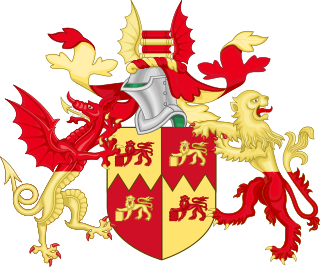
Wrexham is a city and the administrative centre of Wrexham County Borough in Wales. It is located between the Welsh mountains and the lower Dee Valley, near the border with Cheshire in England. Historically in the county of Denbighshire, and later the county of Clwyd in 1974, it has been the principal settlement of Wrexham County Borough since 1996.

Flintshire is a county in the north-east of Wales. It has a maritime border with Merseyside along the Dee Estuary to the north, and land borders with Cheshire to the east, Wrexham County Borough to the south, and Denbighshire to the west. Connah's Quay is the largest town, while Flintshire County Council is based in Mold.

Wrexham County Borough is a county borough, with city status, in the north-east of Wales. It borders the English ceremonial counties of Cheshire and Shropshire to the east and south-east respectively, Powys to the south-west, Denbighshire to the west and Flintshire to the north-west. The city of Wrexham is the administrative centre. The county borough is part of the preserved county of Clwyd.

Wrexham University is a public university in the north-east of Wales, with campuses in Wrexham, Northop and St Asaph. It offers both undergraduate and postgraduate degrees, as well as professional courses. The university had 6,045 students in 2019/20.
Yale College, Wrexham is now part of Coleg Cambria.

Acton is a suburb and community in Wrexham, Wrexham County Borough, Wales. It spans the north-eastern part of Wrexham. The area is largely residential and at its centre, lies Acton Park, the location of the former Acton Hall.
Wrexham was a rural district in the administrative county of Denbighshire from 1894 and 1974.

Deeside College is located in Connah's Quay, Flintshire, North Wales. It was formerly a further education college in August 2013 to create the college for North East Wales.

The Wrexham Maelor Hospital is a district general hospital for the north east region of Wales. It is managed by Betsi Cadwaladr University Health Board.
Denbighshire Constabulary was the Home Office police force for the county of Denbighshire, Wales from 1840 until 1967.

Rhosddu is a suburb and community in Wrexham County Borough, Wales, covering the north-western parts of the city of Wrexham and comprises the wards of Grosvenor, Garden Village and Stansty.

Plas Coch is an area of the community of Rhosddu, in the city of Wrexham, Wales. A major retail and educational area of Wrexham, it lies to the north-west of Wrexham city centre. Formerly known as Lower Stansty, the term has fallen out of use in preference for Plas Coch in recent years, likely due to the popular retail area which shares its name.

Llysfasi College is now part of Coleg Cambria.
Thomas William Jones, Lord Maelor was a British Labour politician.

Wrexham Archives and Local Studies holds the archives for the city of Wrexham. The archives are held at County Buildings, on Regent Street, Wrexham, and run by Wrexham County Borough Council as part of its Wrexham Archives and Local Studies Service. The centre was initially named after local Wrexham historian Alfred Neobard Palmer. The building is shared with Wrexham County Borough Museum and the archives opened in 2002.

The mayor of Wrexham is the civic figurehead and first citizen of the city of Wrexham, and Wrexham County Borough in the north of Wales. The position is elected by members of Wrexham County Borough Council at their annual meeting, and today, holders of the position mainly serve a one-year term. The position is currently held by Councillor Andy Williams of Garden Village, who previously served the role in 2018–2019.

County Buildings is a Grade II listed building in Wrexham, Wrexham County Borough, Wales. It houses the Wrexham County Borough Museum and Wrexham Archives. It is proposed that a Football Museum for Wales be housed in the building. The building is located between Saint Mark's Road and Regent Street in the city centre and Offa, bounded by Wrexham Cathedral to the west.

Abbotsfield is a Grade II listed building in Rhosddu, Wrexham, North Wales.

The School of Creative Arts is the art school of Wrexham University on Regent Street, in Wrexham, North Wales.

The Grove Park School is a former school building in Wrexham, North Wales, which was home to a school between 1939 and 2003. The site has been derelict since 2003, and was proposed for demolition by Wrexham council, until the Welsh Government listed the building in 2016 following a campaign to preserve it. Various bids have been made to re-develop the site, including becoming part of Coleg Cambria, converted into a new primary school or a Welsh-medium secondary school, a medical training facility, and most recently part of a national gallery.


















